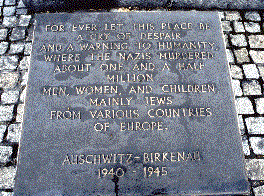The International Holocaust ControversyThe Frame-UpProf. Arthur Butz |
Plaques at Auschwitz | ||

| |||
| Before: Four Million | |||

| |||
| After: One and a half Million |
Our Method, Argument, and Conclusion
There are two political powers involved in the problem, not just one. That is to say, we have a tale of extermination, and we should inquire into the circumstance of its generation. Clearly, there are two states involved in the problem. Germany had an anti-Jewish policy involving, in many cases, deportations of Jews from their homes and countries of citizenship. That is certain. The wartime policy of Washington was to claim extermination, and the post-war policy was to hold trials, at which there was generated the only evidence that we have today that these wartime claims had any foundation. That is also certain. The policies of both states are necessarily of interest, and if there is any respect, in which this book may be breaking fundamentally new ground on the problem, it is in its insistence in seeing Washington as an active agent in the generation of the story. Thus, we are interested not only in what Hitler, Himmler, Göring, Goebbels, and Heydrich were doing during the war in regard to these matters, but also what Roosevelt, Hull, Morgenthau, and the New York Times and associated media were doing during the war, and what the various tribunals controlled or dominated by Washington did after the war. This is not only a fair but more importantly, an illuminating historical approach.
The conclusion is that Washington constructed a frame-up on the Jewish extermination charge. Once this is recognized, the true nature of German Jewish policy will be seen.
The War Crimes Trials
Before we review the details of the story, it should be pointed out that there are excellent a priori grounds for expecting a frame-up. There is of course the very general argument that political enmity of a magnitude to bring on armed conflict between two states necessarily excludes the impartiality on the part of one of them, which is a necessity for a fair trial and for which there exists no substitute. The judges had pursued political careers in the contexts of the internal politics of the Allied powers hostile to Germany and after the trials would, assuming they had not done anything highly improbable at the war crimes trials, return to the careers. They had, in addition, for several years heard only the anti-German viewpoint. In sitting on the military tribunals, they were ad hoc political appointees. Such considerations exclude approximate impartiality.
There are, however, much more specific reasons for expecting a frame-up. In order to see this, it is only necessary to consider the easily obtainable facts concerning the various tribunals involved.
First, there was the “big trial” conducted by the “International Military Tribunal” (IMT) at Nuremberg immediately after the war. This was the trial of the top Nazis Göring, Hess, Ribbentrop, et al., which ran from November 1945 to October 1946. The judges and persecutors were American, British, French, and Russian. As with all “military” tribunals, there was no jury. There were three aquittals, seven prison sentences, and eleven death sentences. The latter were carried out almost immediately after the trial, except that Göring escaped the noose by swallowing a potassium cyanide capsule just before the hangings. It was never determined where Göring had obtained the poison or how he had managed to hide it for any length of time. A unique sequel to this episode was that the first Nuremberg prison psychiatrist, Dr. Douglas M. Kelley, a leader in the treatment of psychiatric disorders with drugs, shortly later published a book on his experiences at Nuremberg, giving Göring and Göring’s last act a laudatory treatment:31
He stoically endured his long imprisonment that he might force down the Allied Tribunal and browbeat the prosecuting lawyers on their own terms. [...] His suicide [...] was a skillful, even brilliant, finishing touch, completing the edifice for Germans to admire in time to come. [...] History may well show that Göring won out at the end, even though condemned by the high court of the Allied powers.
A decade later, Dr. Kelley followed Göring by taking one of several potassium cyanide capsules which he possessed, said to be ‘souvenirs’ taken off Göring’s body.
The IMT trial was the only one that received very great attention. It was important in the sense that the Allied powers committed themselves to a specific version of the extermination claim, but there was little evidence presented of any substantial nature relative to Jewish extermination; it was almost entirely testimony and affidavits, not at all difficult for the victorious powers to produce under the circumstance. The only relative merit of the IMT trial, for our purposes, is that the complete transcript and a reasonably complete selection of the documents put into evidence are readily available in numerous libraries as a 42-volume set with a very complete subject and name index.
31. Douglas M. Kelley, 22 Cells in Nuremberg, Greenberg, New York, 1947, pp.76-77; New York Times 2 Jan. 1958, p. 18; Wilmot Robertson, The Dispossessed Majority, Howard Allen, Cape Canaveral, Florida, 1972, p. 266.
Arthur R. Butz, The Hoax of the Twentieth Century, Castle Hill Publishers, 2003, pp. 33-35, first published by Historical Review Press, 1976.